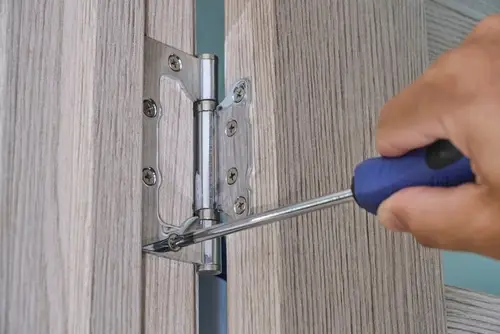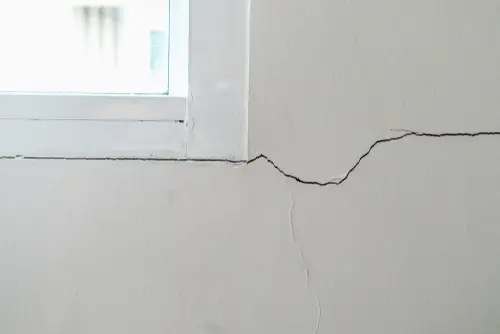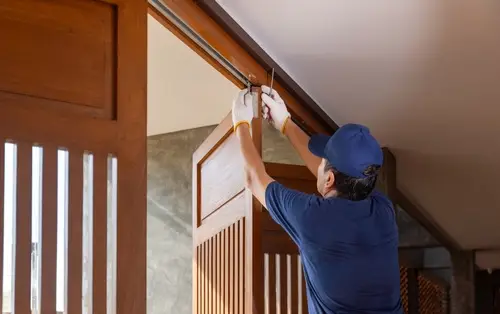A sagging door can be more than just an annoyance—it can cause sticking, misalignment, and even damage to your flooring or frame. Whether your door is scraping the floor, swinging shut on its own, or refusing to close properly, learning how to fix a sagging door is easier than you might think. This guide walks you through solutions for repairing a sagging door and lets you know when it’s time to call in a pro.
Tools & Materials You’ll Need to Fix a Sagging Door
Before you start trying to fix a sagging door, make sure you have these tools and materials ready:
- Flathead or Phillips screwdriver (manual, not a drill)
- Wood glue
- Toothpicks or wooden dowels
- 3-inch screws (to reach wall stud)
- Sandpaper or belt sander
- Hinge shims (optional but helpful)
- Drill (optional for screw replacement)
- Level (to check door alignment)
- Pencil (for marking adjustments)
Pro Tip: Avoid power drills when tightening hinge screws—it's easy to over-tighten or strip the holes, which can make your door sag worse.
Step-by-Step: How to Fix a Sagging Door
Fixing a sagging door might seem intimidating at first, but most fixes are simple enough with the right approach. Follow these step-by-step tips to repair a sagging door and restore proper alignment.
Step 1: Tighten the Door Hinges
The most common cause of door sagging is loose hinge screws. Daily use can cause the screws to loosen over time, allowing the door to drop slightly out of alignment.
Use a manual screwdriver (not a drill) to tighten each screw on the top and middle hinges. Even a small adjustment can help fix door sag and realign the door in the frame.

Step 2: Fill Stripped Screw Holes
If the hinge screws won’t tighten, the screw holes may be stripped or too wide for the screw to grip. To fix a sagging door with stripped screw holes, fill the holes with toothpicks coated in wood glue (or use wooden dowels for a stronger hold). Let the glue dry, then reinsert the screws. This helps you secure the hinges properly and repair the sagging door without replacing it.
Step 3: Replace a Hinge Screw with a Longer One
Sometimes, a sagging door needs deeper support. Replace the center screw on the top hinge with a 3-inch screw that reaches into the wall stud behind the door jamb. This will add strength and pull the door back into place.
Check all screws again to make sure they’re secure. This step can fix door sag without sanding or structural changes. If the door still doesn't latch properly after you fix the sag, the issue could be with the strike plate or latch alignment. Here’s how to fix a loose door latch to ensure a secure close.
Step 4: Sand the Door Edges
If you’ve checked the hinge screws and the door still sticks or rubs against the frame, the edges may need sanding. Use sandpaper or a belt sander to gently shave down the areas where the door is making contact.
Fixing a sagging door doesn't require removing much wood, so sand conservatively. After each pass, close the door to test the fit until it swings freely and without resistance.
Step 5: Install a Hinge Shim (Optional)
If you’ve tightened the hinges and filled the holes but still see uneven spacing, try installing a hinge shim behind the lower hinge. This thin plastic spacer helps lift the bottom corner of the door and restore it to its proper alignment.
Pro Tip: Adding a shim is an easy, effective way to repair a sagging door without removing or adjusting the entire frame.
Step 6: Check for Structural Shifting
Still having issues? Your sagging door may be a sign of a larger problem, like the foundation settling unevenly. If your home has shifted, the door frame may be uneven or out of square.
Check for cracks in walls or floors near the door. If you're still having difficulty, consult a professional to rule out bigger issues. Addressing the source of door sagging helps prevent recurring problems.
Pro Tip: These fixes work for most swinging interior or exterior doors. If you're experiencing screen door issues, check out our guide on how to fix a sagging screen door for step-by-step help.

When to Call a Professional to Fix a Sagging Door

Most sagging door issues can be fixed with a screwdriver, some wood glue, and a little patience. But in some cases, the problem goes deeper, and typical DIY solutions just won’t cut it.
If you’ve tried the steps above and your door is still sagging, or you’ve noticed signs of structural shifting, it’s time to call in a professional. A trained handyman or carpenter can:
- Repair a sagging door caused by frame damage
- Realign or replace warped door jambs
- Fix door sag due to foundation settling or wall movement
- Install new hinges, shims, or hardware with precision
If the issue persists, don’t waste time trying fix after fix. Local Mr. Handyman® service professionals can repair your sagging door correctly, saving you time, stress, and repeat repairs.
This article is intended for general informational purposes only and may not be applicable to every situation. You are responsible for determining the proper course of action for your home and property. Mr. Handyman is not responsible for any damages that occur as a result of this blog content or your actions. For the most accurate guidance, contact your local Mr. Handyman location for a comprehensive, on-site assessment.
Frequently Asked Questions on How to Fix a Sagging Door
Mr. Handyman has been helping homeowners and businesses repair, maintain, and enhance their spaces for over 25 years! We are the one-stop solution for everything on your to-do list. This includes answering your questions about home repairs, maintenance, and improvements. Here are answers to some of your most frequently asked questions on how to fix a sagging door.
What causes a door to sag over time?
A sagging door is usually caused by loose hinges, worn-out screws, or a misaligned frame. In some cases, moisture, humidity, or foundation settling can affect the door’s fit and cause it to hang unevenly.
How do you fix a sagging door that won’t close?
To fix a sagging door that won’t close, first tighten the hinge screws. If that doesn’t work, fill any stripped screw holes for a more secure hold, replace the center screw with a longer one, and sand down the edges where the door sticks. If needed, use a hinge shim to improve alignment.
Can a sagging door be fixed without removing it?
Yes, you can often repair a sagging door without removing it. Most fixes, like tightening screws, replacing them with longer ones, or adding a shim, can be done with the door still in place. Removing the door is only necessary for severe misalignment or damage.
When should I call a professional to fix door sag?
Call a professional to address a sagging door if:
- DIY methods don’t work
- The door frame is warped or damaged
- You suspect foundation issues are causing the misalignment
A professional handyman can assess and repair a sagging door properly and prevent long-term problems.




